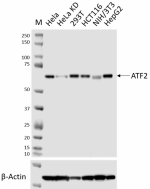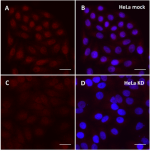- Clone
- W21106A (See other available formats)
- Regulatory Status
- RUO
- Other Names
- activating transcription factor 2 formerly, ATF2, cAMP-responsive element-binding protein 2, CREB2, CREBP1, CRE-BP1, cyclic AMP-dependent transcription factor ATF-2, HB16, MGC111558, TREB7
- Isotype
- Rat IgG2b, κ
- Ave. Rating
- Submit a Review
- Product Citations
- publications

-

Whole cell extracts (15 µg total protein per lane) from the indicated cell lines (lane 1 and 2 are HeLa cells without and with ATF-2 knockdown, respectively) were resolved on a 4-12% Bis-Tris gel, transferred to a PVDF membrane, and probed with 1 µg/mL of purified anti-ATF-2 (clone W21106A) overnight at 4°C. Proteins were visualized by chemiluminescence detection using HRP Goat anti-Rat IgG (Cat. No. 405405) at a 1:5000 dilution. Direct-Blot™ HRP anti-β-actin (Cat. No. 664804) was used as a loading control at a 1:25000 dilution. Western-Ready™ ECL Substrate Premium Kit (Cat. No. 426319) was used as a detection agent. Lane M: Molecular weight marker -

HeLa cells without (panel A and B) and with (panel C and D) ATF-2 knockdown were fixed with 4% paraformaldehyde for 10 minutes, permeabilized with 0.5% Triton-X, and then blocked with 5% FBS for 1 hour at room temperature. Cells were then intracellularly stained with 10 µg/mL of purified anti-ATF-2 (clone W21106A), followed by incubation with 2.5 µg/mL of Alexa Fluor® 594 Goat anti-rat IgG (Cat. No. 405422) for 1 hour at room temperature. Nuclei were counterstained with DAPI (Cat. No. 422801). The image was captured with a 40X objective. Scale bar: 25 µm
| Cat # | Size | Price | Quantity Check Availability | Save | ||
|---|---|---|---|---|---|---|
| 630051 | 25 µg | 164€ | ||||
| 630052 | 100 µg | 396€ | ||||
The Activating Transcription Factor 2 (ATF-2), also known as CREB2 and CREBP1, contains a Basic Leucine Zipper (bZIP) domain and a C2H2-type zinc finger domain. ATF-2 binds to both DNA response factors AP-1 and CRE and belongs to the ATF/CREB family of leucine zipper proteins. ATF-2 interacts with a variety of viral oncoproteins and cytosolic tumor suppressors and is a target of the SAPK/JNK and p38 MAP kinase signaling pathways. ATF-2 activity can be initiated by various forms of cellular stress. Several studies have shown aberrant ATF-2 activation in the development and progression of mammalian skin tumors. ATF-2 may mediate carcinogenesis induced by the mutant Ras protein and regulate the maintenance of the invasive cancer phenotype of several epithelial cell types. ATF-2 has also been shown to be phosphorylated at its C-terminus (serine 472 and 480 in mice, serine 490 and 498 in human) by ATM during double-strand breaks. Mice with mutations of these two serines are sensitive to irradiation and more prone to tumorigenesis under p53 knockout condition.
Product DetailsProduct Details
- Verified Reactivity
- Human, Mouse
- Antibody Type
- Monoclonal
- Host Species
- Rat
- Immunogen
- Partial Recombinant human ATF2 protein
- Formulation
- Phosphate-buffered solution, pH 7.2, containing 0.09% sodium azide
- Preparation
- The antibody was purified by affinity chromatography.
- Concentration
- 0.5 mg/mL
- Storage & Handling
- The antibody solution should be stored undiluted between 2°C and 8°C.
- Application
-
WB - Quality tested
ICC - Verified - Recommended Usage
-
Each lot of this antibody is quality control tested by western blotting. For western blotting, the suggested use of this reagent is 0.125 - 1.0 µg/mL. For immunocytochemistry, a concentration range of 2.0 - 10.0 μg/mL is recommended. It is recommended that the reagent be titrated for optimal performance for each application.
- Application Notes
-
The clone cross-reacts with mouse in western blot (WB).
For immunocytochemistry (ICC), 4% PFA fixation followed by permeabilization with 0.5% Triton X-100 is recommended.
This product is not recommended for use in immunohistochemistry (IHC). - Additional Product Notes
-
This antibody has been tested in knockout/knockdown models for Western Blotting and Immunocytochemistry.
- RRID
-
AB_3097336 (BioLegend Cat. No. 630051)
AB_3097336 (BioLegend Cat. No. 630052)
Antigen Details
- Structure
- ATF-2 protein is a 505 amino acid protein with a predicted molecular weight of 55 kD
- Distribution
-
Abundant expression in the brain
- Function
- Transcriptional activator
- Interaction
- SMAD3, SMAD4, UTF1, NBN, MRE11, XPO1, KAT5, CUL3
- Biology Area
- Cell Biology, DNA Repair/Replication, Transcription Factors
- Antigen References
-
- Abdel-Hafiz, H.A. et al. 1992. Mol Endocrinol. 6:2079-89.
- Gupta S, et al. 1995. Science. 267:389-93.
- Van Dam H, et al. 1995. EMBO J. 14:1798-811.
- Livingstone C, et al. 1995. EMBO J. 14:1785-97.
- Yamasaki T, et al. 2009. J Cell Biochem. 284:8567-81.
- Leslie MC, et al. 2009. J Cell Biochem. 94:25–38.
- Papassava P, et al. 2004. Cancer Res. 64:8573–84.
- Vlahopoulos SA, et al. 2008. BioEssays. 30:314–27.
- Bhoumik A, et al. 2005. Mol.Cell. 18:577–87.
- Li S, et al. 2010. Genes Cancer. 1:316–330.
- Gene ID
- 1386 View all products for this Gene ID
- UniProt
- View information about ATF-2 on UniProt.org
Related Pages & Pathways
Pages
Related FAQs
Other Formats
View All ATF-2 Reagents Request Custom Conjugation| Description | Clone | Applications |
|---|---|---|
| Purified anti-ATF-2 | W21106A | WB,ICC |
Compare Data Across All Formats
This data display is provided for general comparisons between formats.
Your actual data may vary due to variations in samples, target cells, instruments and their settings, staining conditions, and other factors.
If you need assistance with selecting the best format contact our expert technical support team.
 Login / Register
Login / Register 









Follow Us